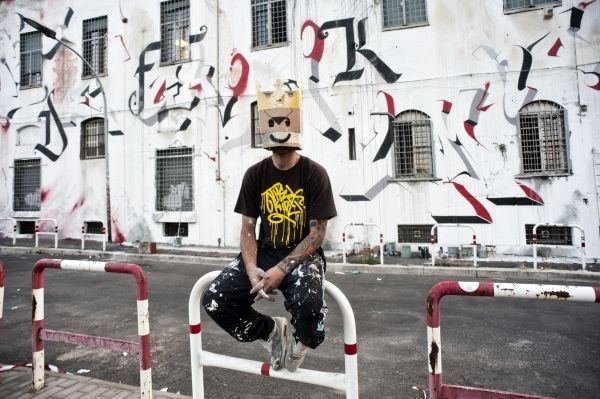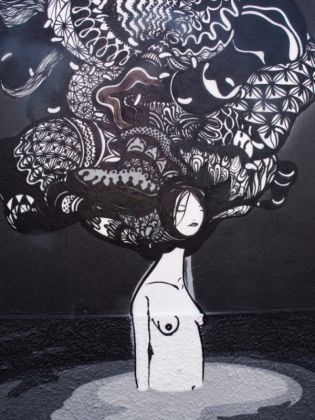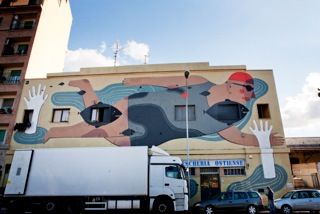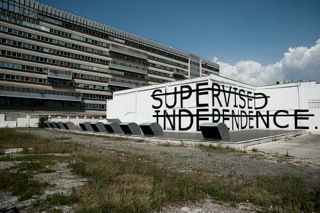Street art: off the wall?
Street art in Rome reaches new creative heights
From ancient Pompeii to the façades of buildings today, graffiti has been making walls, and people, talk for centuries. The word “graffiti” is derived from the Italian verb “to scratch”. For some, street art is like a rash that only spreads when one tries to rub it away; for others, walls are a creative platform for expressing political opinion and delivering social and cultural messages. Whichever side one takes, clean-up initiatives paired with designated legal walls and commissioned projects allow those in both camps to scratch their itches.
Former mayor of Rome Gianni Alemanno was elected in 2008 after pledging to make graffiti see the writing on the wall. He created a city ordinance mandating that offenders remove their own work from walls and he also raised the minimum fine for graffiti from €25 to €300. Organisations such as Urban Décor Squad and even foreign diplomats joined the effort, picking up the pail to paint over the illegal art.
Since then, other organisations have taken a more creative approach to controlling graffiti. Retake Roma, a grassroots non-profit association, aims to eliminate vandalism while encouraging legal public artwork by organising wall clean-ups in parallel with mural painting.
A similar foundation, Insieme per Roma, commissioned Alessandro Sabong to transform a vandalised outdoor staircase in Rome’s EUR district into a cascading waterfall; now commuters experience a small miracle each day as they walk on water on their way to the nearby Laurentina metro station. Going a step farther, Nufactory seeks out talented artists, helps them find sanctioned spaces to stretch their skills, and promotes them through events like the annual Outdoor Urban Art Festival.
Outdoor has showcased street art since 2010, legitimising it as an art form and engaging the public in wall talks, dialogue about the issues that such art portrays. Antonella Di Lullo, the festival’s curator, summarised the event as “moments of encounter and exchange in which we reflect on the world of street art and its inescapable connection with the district.”
This year’s instalment, held from 6-14 September in the Ostiense area, highlighted popular urban artists such as Rero, Luca Di Maggio and Sten & Lex, and photographers Niccolò Berretta and Martha Cooper under the theme of “What a wonderful city”.
“For this edition we chose to look at the change that is currently transforming Rome into a new European hub of creativity,” Di Lullo said. “[It is] a radical transformation that, in contrast to all prejudice and disapproval, leads us to exclaim wondrously, ‘What a wonderful city!’”
What does it mean to be a wonderful city? A photo of a street sign from Outdoor’s Facebook page says it all; its three arrows point in different directions, one each toward “right,” “wrong,” and “colors”. The debate, whether street art is right or wrong for Rome, falls by the wayside in light of the colour the art adds to the city. The contrasting hues of Rome’s colourful culture could be seen through the festival’s multiple art forms including murals, photography, cinema, architecture and music. Outdoor plans to continue opening people’s eyes to new art and leaving its mark on the city next year with Outdoor 5.
In July 2012, Rome began seeing street art in more than just black and white terms. It opened itself to the colourful culture by reaching an agreement with WALLS, a graffiti artist group. Select artists were granted exclusive permission to create art on walls marked with plaques bearing the inscription “hall of fame”, while all artistsare welcome to walls marked “muri liberi”. A complete list and location of walls can be found on Urban Act’s website www.urbanact.it.
Urban art is also popping up in traditional institutes. Trastevere’s Museo di Roma showcased Diamond, an internationally known street artist, last summer. Casa del Architettura -1 art gallery recently displayed work by Alice Pasquini, a high profile visual artist from Rome, and launches an exhibition by Mr Klevra and Omino71 on 7 January. Mayor Ignazio Marino and the Capitoline Museums have commissioned Pasquini as well as Luca Masters and Bol23 to create pieces to decorate government office spaces to send the message that the city’s leaders are connected to their constituents.
The Galleria Varsi (www.galleriavarsi.it) located at Via di S. Salvatore in Campo 51, not only displays urban art but it also sells street artists’ work through its website. This demonstrates the internet’s role in extending urban art’s impact beyond the physical limitations of walls. Mondo Pop, an international art gallery and shop located near the Spanish Steps, makes art accessible with its affordable prices and events.
But true to street art style, nothing compares to roaming the city’s roads and happening upon the art; in this case hitting a wall can be an inspirational breakthrough. To find the walls, wander the neighbourhoods of Ostiense, S. Lorenzo, Pigneto and Trastevere, especially around the metro stations and underpasses. In the nooks and crannies one can find true technique amid sloppy sprayings. In Ostiense, consider it good luck if you get to see the black cat titled “Catalogue” painted on an underpass. You might even be able to say you saw the wall scrawled with “Quotes Calligraphic”. If you really want street art that makes a splash, sidle up to the “Swimmer”, a cheery man in a red swim cap and uni-bathing suit swimming up Via del Porto Fluviale.
Some other ideas: slither down Via Prenestina to see Hopnn’s “Medusa”; build up your street art repertoire at the social centre Forte Prenestino in Centocelle; enter the Metropoliz’s space in Tor Sapienza and see the Museo dell’Altro e dell’Altrove di Metropoliz_ città meticcia (MAAM); pause to see the still pictures now portrayed at the former cinemas Preneste in Pigneto and Volturno in Termini; take a friend to S. Lorenzo to see La Communia where Hogre, Mr Klevra and Omino71, the show off their skills; and to really drink it in, grab a beer at the pub Strike off Via Portonaccio and hit up one of Strike’s social events. Who knows? You might just strike gold.
Sarah Barchus


























